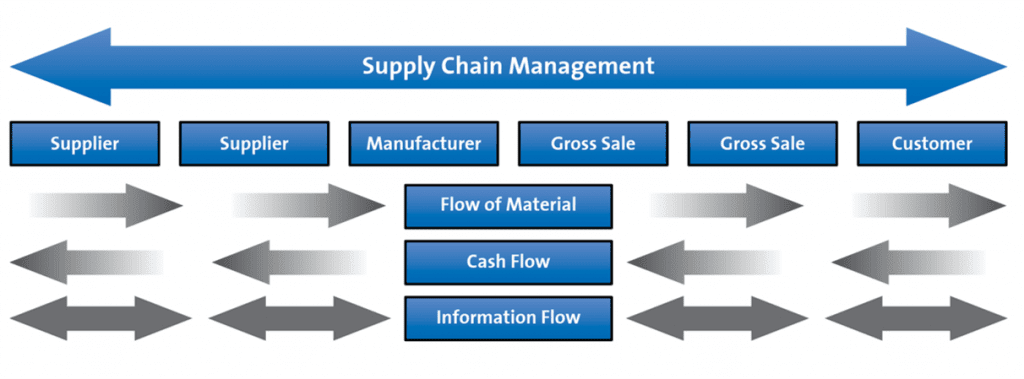This section deals with the question of how digitalisation enables companies to increase robustness in complex supply chains.
International trade rose rapidly in value and quantity in the second half of the twentieth century.[1] This has resulted in complex interdependencies, which means that the isolated consideration of individual markets/ companies is often impossible nowadays.
At the same time, market conditions transformed fundamentally – the intensified competition stemming from globalisation, such as greater customer demand for product variety or shorter product life cycles, confronts companies with challenges that often cannot be handled within the organisation. Instead, as part of a make-or-buy analysis, companies identify core competencies and potentially outsource non-core product components or services to suppliers. The result of this development, for example in the automotive industry, is the fact that up to 70% of the company´s value is supported by suppliers.[2] At the extreme end of the supplier-supported value spectrum are highly successful digital companies, such as Airbnb and Uber, who essentially rely on suppliers for all their resources. Central management philosophies in the supply chain environment include just-in-time (JIT)[3] production and Kanban.[4] In addition, logistics providers can be engaged, which can provide global logistics services from a single source due to their global partner network.
The advantages of outsourcing include the use of low-cost structures at suppliers, participation in highly specialised know-how, flexibility and optimal utilisation of capacity. The planning and coordination of information, payment and material flows with numerous network partners, and production distributed to numerous countries, are highly complex in these enterprise networks. Two examples of this complexity follow.
The first is from the automotive industry.
At the time of the Ford Model T, Henry Ford explained that customers could buy a Ford in any colour – as long as it was black.
Contrast Ford’s statement with a microcar that was unveiled at the 2012 Paris Motor Show, which allowed configuration of more than 30,000 different variants of its exterior design.[5]
Such a wealth of options can only be realised through the use of many different components. Similarly, a VW Beetle from the year 1965 consists of fewer than 5,000 parts, while the production of a modern luxury class car requires more than 10,000 parts.[6] This results in immense demands on the logistics processes.
Assuming that the 10,000 items are divided into 500 installable modules, a 99.9% error-free delivery level would lead to an error rate of 40% for the overall process, which of course is unacceptable. However, a 99% smoothly running installation process requires a 99.999% error-free supply process.

The second example is the bullwhip effect to describe fluctuations in demand, which gradually increase along the supply chain[7] as indicated in the figure above.[8] When customer demand increases, dealers do not respond to an order in proportion to the actual quantity demanded, but instead adjust their demand forecast upward. Therefore, the upstream wholesaler no longer adjusts its order size in line with customer demand. The isolated consideration of demand or stock levels increases the degree of variation at each stage of the supply chain, since the basis of the decision is no longer the moderately fluctuating retail demand, but instead includes the variability of each stage.
The main causes of this effect are order contract bundling, reactions to price fluctuations and the effects of long order lead times, plus the reaction of customers to perceived rationing by increasing purchases or speculation during demand overhangs by increasing stock levels, in the belief that demand is stronger than supply. The following figure[9] shows how the bullwhip effect leads to worsening planning along and across the supply chain, in cases of insufficient coordination.

On the assumption that companies will add even more components to their global supply chains in the future, digitalisation can make valuable contributions to keeping these supply chains efficient and optimised.
Far more precise planning than in the past is possible by using analytics and big data approaches. Targeted communication along the supply chain and automated, data-driven, real-time decision-making improves cooperation between partners. Also, the service provider mindset of a digital company facilitates rapid coupling and uncoupling of business partners in the supply chain.
In fact, digitally enabled supply chains with a variety of enablers for efficient vertical integration of parts and services, as well as flexible horizontal collaboration between partners and suppliers, are fully aligned with the emerging Industry 4.0 vision.[10]
_____
[1] Schieck, A.: ‘Internationale Logistik: Objekte, Prozesse und Infrastrukturen grenzüberschreitender Güterströme’, De Gruyter Oldenbourg, p. 29, 2008.
[2] Roventa, P., Weber, J.: ‘Automobilzulieferer-Mittelstand – quo vadis?’, Corfna AG, 2004.
[3] Ohno, T.: ‘Toyota Production System: Beyond Large-scale Production’, Taylor & Francis Ltd., 1988.
[4] Anderson, D. J.: ‘Kanban: Evolutionäres Change Management für IT-Organisationen’, Dpunkt Verlag, 2011.
[5] Anker, S.: ‘Mit dem Golf nur acht Mal pro Jahr zur Tankstelle’, Die Welt Online, 2012.
[6] Zellner, M.: ‘10.000 Einzelteile in einem Auto – viel Potenzial für Fehler’, Die Süddeutsche Zeitung Online, 2010.
[7] Lee, H. L., Padmanabhan, V., Whang, S.: ‘The Bullwhip Effect in Supply Chains’, MIT Sloan Management Review, p. 93, 1997.
[8] Fredebeul, M.: ‘Supply Chain Management und Beschaffungslogistik: Einflussfaktoren und Auswirkungen’, Vdm Verlag Dr. Müller, 2007.
[9] Lee, Padmanabhan, Whang: p. 94.
[10] Schrauf, S., Berttram, P.: ‘Industry 4.0 – How digitization makes the supply chain more efficient, agile, and customer-focused’, PwC, 2016.

